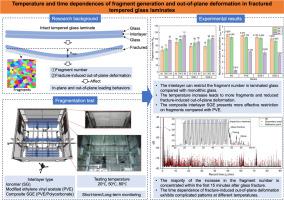Temperature and time dependences of fragment generation and out-of-plane deformation in fractured tempered glass laminates
IF 6.6
1区 工程技术
Q1 ENGINEERING, CIVIL
引用次数: 0
Abstract
The fragment number and out-of-plane deformation in tempered glass laminated with temperature- and time-dependent interlayers, which are important results after glass breakage, significantly affect the tension stiffening effect in post-fracture laminated glass (LG) and its geometrical imperfection, respectively. This paper explored the two objective physical quantities based on the fragmentation experiment. The study would contribute to the performance assessment and prediction of LG in the Post Fracture Limit State. The ionomer (SentryGlas®, SG), modified ethylene-vinyl acetate (PVE®), and PVE-based composite interlayers (SGE®) were considered. The testing temperatures were set at 20 °C, 50 °C, and 80 °C. Besides, long-term monitoring of the examined objectives was conducted based on voice recording and distance measurement. The results reveal that a stiffer interlayer can restrict the fragment generation and number in LG compared with monolithic glass (MG), whereas the influence weakens with increasing temperature. The fragment number in SG LG decreases by 30.91 % and 27.98 % compared to MG with the same surface stress at 20 °C and 50 °C, respectively. In addition, the temperature rise for all series and the thicker polycarbonate layer for SGE series result in decreased out-of-plane deformation. The stiffer SGE has a weaker restriction on the fragment number. Furthermore, the fragment number gradually increases due to the generation of secondary cracks. The increase within the first 15 min after glass fracture becomes more pronounced as the temperature rises. The time dependence of fracture-induced out-of-plane deformation in LG exhibits complicated patterns, where the variation trend at 20 °C is contrary to that observed at 50 °C and 80 °C.

破碎钢化玻璃层合板碎片生成及面外变形的温度和时间依赖性
温度和时间相关夹层夹胶钢化玻璃的碎片数和面外变形是玻璃破碎后的重要结果,它们分别显著影响破裂后夹层玻璃(LG)的拉伸加劲效果及其几何缺陷。本文在破碎实验的基础上,探索了两个客观物理量。研究结果可为LG在断裂后极限状态下的性能评价和预测提供依据。考虑了离聚体(sentryglass®,SG)、改性乙烯-醋酸乙烯酯(PVE®)和基于PVE的复合中间层(SGE®)。测试温度分别设置为20℃、50℃和80℃。此外,通过录音和距离测量对被测目标进行了长期监测。结果表明:与单片玻璃(MG)相比,更硬的夹层可以限制LG玻璃碎片的产生和数量,但随着温度的升高,这种影响减弱。在20°C和50°C温度下,SG - LG的碎片数比相同表面应力下的MG分别减少了30.91%和27.98%。此外,所有系列的温度升高和SGE系列的聚碳酸酯层较厚导致面外变形减小。较硬的SGE对片段数的限制较弱。此外,由于二次裂纹的产生,碎片数逐渐增加。随着温度的升高,玻璃破碎后15分钟内的升高更为明显。LG断裂诱发面外变形的时间依赖性表现出复杂的模式,其中在20℃时的变化趋势与在50℃和80℃时的变化趋势相反。
本文章由计算机程序翻译,如有差异,请以英文原文为准。
求助全文
约1分钟内获得全文
求助全文
来源期刊

Thin-Walled Structures
工程技术-工程:土木
CiteScore
9.60
自引率
20.30%
发文量
801
审稿时长
66 days
期刊介绍:
Thin-walled structures comprises an important and growing proportion of engineering construction with areas of application becoming increasingly diverse, ranging from aircraft, bridges, ships and oil rigs to storage vessels, industrial buildings and warehouses.
Many factors, including cost and weight economy, new materials and processes and the growth of powerful methods of analysis have contributed to this growth, and led to the need for a journal which concentrates specifically on structures in which problems arise due to the thinness of the walls. This field includes cold– formed sections, plate and shell structures, reinforced plastics structures and aluminium structures, and is of importance in many branches of engineering.
The primary criterion for consideration of papers in Thin–Walled Structures is that they must be concerned with thin–walled structures or the basic problems inherent in thin–walled structures. Provided this criterion is satisfied no restriction is placed on the type of construction, material or field of application. Papers on theory, experiment, design, etc., are published and it is expected that many papers will contain aspects of all three.
 求助内容:
求助内容: 应助结果提醒方式:
应助结果提醒方式:


